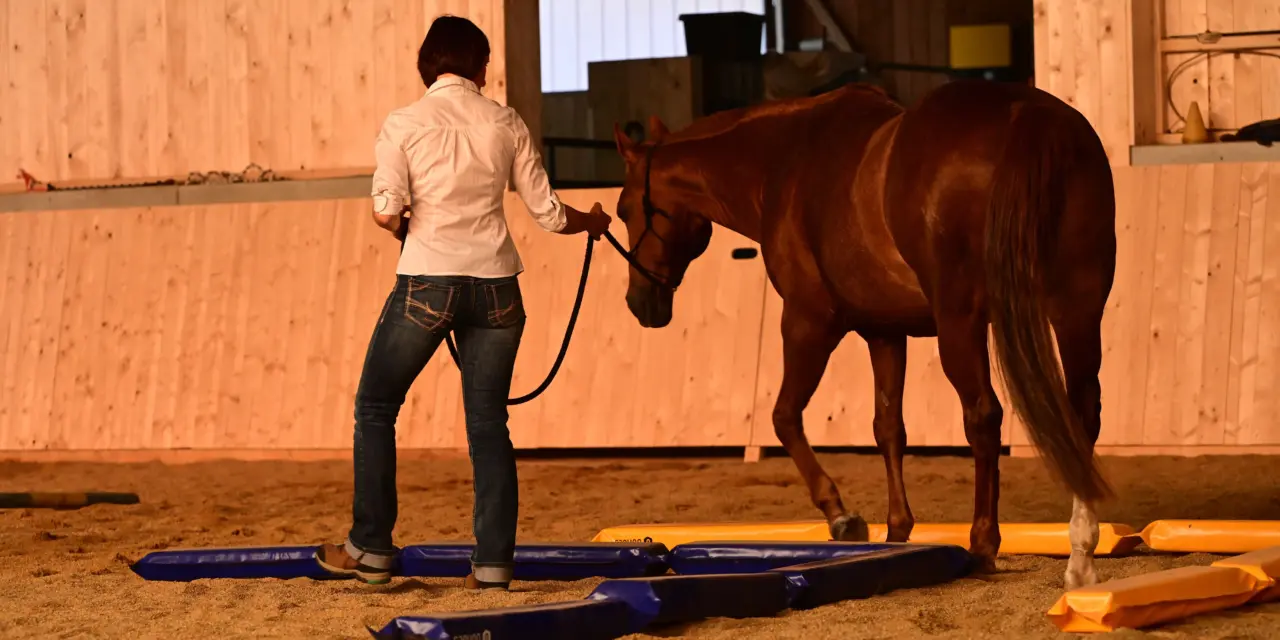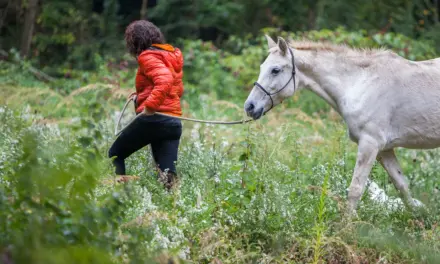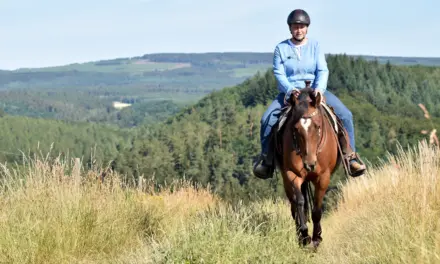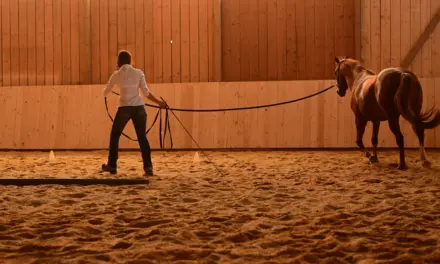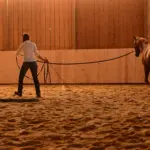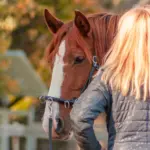Key points at a glance:
- Safety comes first – Fenced, level areas without potential hazards provide the best learning environment.
- The surface determines comfort and injury risk – A grippy, springy footing protects the joints and provides good support.
- Use distractions deliberately – A quiet environment for beginners, controlled stimuli for more advanced horses.
- Groundwork works everywhere – From the arena to a simple hack, you can integrate exercises anywhere.
- Preparing the space is part of the training – Setting up the working area together strengthens your partnership.
Choosing the right place to train is crucial for successful groundwork with your horse. While a perfectly set up arena might seem ideal, there are actually many different options – because ultimately, every interaction with your horse is a form of groundwork.
Safety – the foundation of every training session
A safe training area forms the foundation for relaxed, successful work. Ideally, the working space should be fully fenced so that the horse cannot run off if it takes fright or pulls away. An area of roughly 15 x 30 metres offers enough room for most groundwork exercises without feeling cramped, but it can of course be larger, especially if other horse-and-rider pairs are using it at the same time.
The area should be checked for potential hazards before every training session. Protruding nails, sharp edges, holes in the ground or objects lying around can quickly lead to injury. The condition of the fencing is particularly important, too. Electric fencing or barbed wire is unsuitable for groundwork, as horse and handler may be working very close to the fence. If the area is fenced with electric tape, the power should definitely be switched off before you start. The horse will not necessarily realise that the fence is no longer live and may still jump aside if it accidentally touches it.
Sufficient distance from busy roads or other sources of noise is important. A frightened horse can react unpredictably, and you simply need enough space to be able to control the situation safely. Where possible, you should also plan escape routes for the handler. Corners or areas where you could become trapped should be avoided. A round pen with high, solid walls is also not suitable for beginners working alone with their horse.
The surface – the foundation of healthy training
The surface plays a crucial role in your horse’s health and in the quality of your training. An ideal area for groundwork offers good grip without being too deep. Sand–fibre mixes have proved their worth if you want to work your horse in a wide range of weather conditions.
Surfaces that are too hard, such as tarmac or concrete, should be avoided, as they put strain on the horse’s joints and can lead to serious injury in the event of a fall – unless the horse has been advised by a vet to walk only on hard ground.
Conversely, footing that is very deep and soft is just as problematic, because it overworks the tendons and ligaments, causes the horse to tire rapidly and makes it difficult for you to keep up alongside.
When it’s wet, the surface should not become slippery – this is where the quality of the footing really shows. A well-drained arena dries quickly and remains usable even in poor weather. If you do not have access to a purpose-built arena, a level field with firm ground can also work well, as long as it is not too uneven or full of holes.
You also always need to bear in mind which type of surface each individual horse copes well with. What may already be too slippery or too deep for one horse, because it is still very unbalanced, can be perfectly fine for another.

Turning distractions into training tools
For beginners in groundwork, a quiet, distraction-free environment is ideal. The horse can focus fully on the handler and their signals, without being disturbed by external stimuli. The best times are when the yard is quiet, and you should work well away from other horses or busy areas.
As training progresses, however, distractions can be used deliberately as a training aid. A horse that has learnt to stay attentive even when there is a lot going on around it becomes a reliable partner in all situations. The level of distraction should be increased gradually – starting with other horses in sight and slowly building up to more complex situations.
It is particularly valuable if the horse learns to concentrate fully even in its familiar yard environment. This creates a solid foundation for all further activities, from relaxed grooming right through to loading or a visit from the vet.
Groundwork everywhere – every interaction is training
An important idea in modern horse training is the realisation that every interaction with your horse is groundwork. Whether you are bringing it in from the field, leading it to the grooming area or going for a walk in hand – you are always communicating, and there is always an opportunity to improve that communication.
On a walk, there are countless opportunities to incorporate elements of groundwork. A fallen tree can become an obstacle for leading exercises, a small rise can serve as a platform for confidence training. Halting at different points, stepping backwards around bends or standing still on cue – all of these are valuable exercises that enrich the walk and strengthen your relationship with your horse.
This kind of integrated groundwork has the advantage that it happens in a natural, unforced way. The horse learns that the cues it has been taught apply not only in the training arena, but everywhere horse and handler spend time together. This builds mutual trust and makes the horse a more pleasant and safer companion for the human, while at the same time turning the human into a reliable partner for the horse in all situations.
Taking weather conditions into account
Not every kind of weather is equally suitable for groundwork. In strong winds, horses can become nervous and inattentive, as their natural instincts put them on high alert. Such days are better suited to quieter exercises, or the session should be moved to a sheltered indoor school.
Heat puts a strain on both horse and handler. Training sessions should be planned for the cooler morning or evening hours, with plenty of water breaks. In frosty conditions the ground becomes slippery and hard – particular care is needed to avoid injury.
Rain does not necessarily have to mean the end of a training session. Many horses actually work more attentively in light rain, as there are fewer distractions and, especially in summer, no annoying flies. The important thing is that the ground does not become too slippery and that both partners are adequately protected from getting wet. This is particularly true as autumn approaches, when horses may not yet have enough winter coat and can get cold if they get soaked.
Making use of alternative training areas
Not every horse owner has access to a perfect training arena. Even in less-than-ideal conditions, however, you can still work successfully. A wide path in the stable block can be used for the first leading exercises, and a paved yard is also suitable for in-hand work and basic obedience.
Covered areas are particularly valuable, as they allow you to train regardless of the weather. Even a large open barn can temporarily serve as a training space when the other horses are occupied elsewhere.
Less conventional training locations should also be included. On the way to the paddock, around the hay feeders or even by the lorry or trailer, you can incorporate elements of groundwork – and in this way, you can continuously improve your relationship with your horse.
Getting the training area ready can already be part of your groundwork. If the horse watches while you set up obstacles or pick up droppings in the arena, it is already learning to wait patiently and stay attentive.
Walking round the training area together before you start the actual work is also valuable. The horse can inspect its surroundings, notice any changes and mentally prepare for the session ahead. This quiet initial phase helps both partners to settle and tune in to one another.
Conclusion – flexibility is the key
The ideal training area for groundwork does not have to be perfect – it has to be safe. With a bit of creativity and the right mindset, you can work successfully with your horse almost anywhere. What matters is to assess the conditions realistically, take all safety aspects seriously and make the best possible use of the facilities you have.
The best groundwork often happens spontaneously and without a set plan. Attentive, mindful handling in everyday interactions is at least as valuable as a structured training session in the perfect arena. Every moment with your horse should be seen as a chance to communicate and to strengthen your partnership.
- The right equipment for groundwork - 10. November 2025
- The ideal training ground - 10. November 2025
- Mental preparation of the person - 10. November 2025

